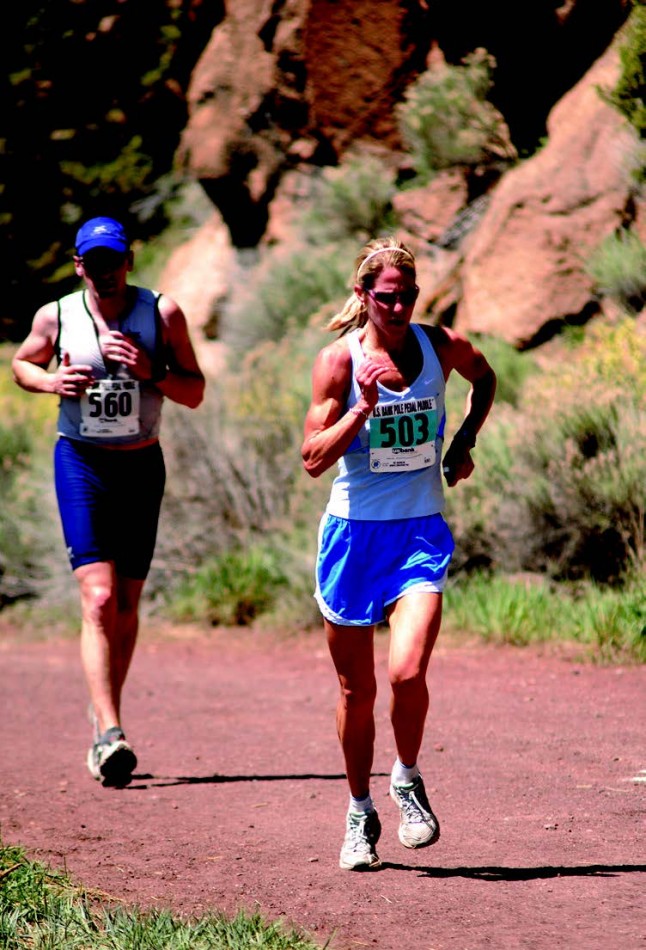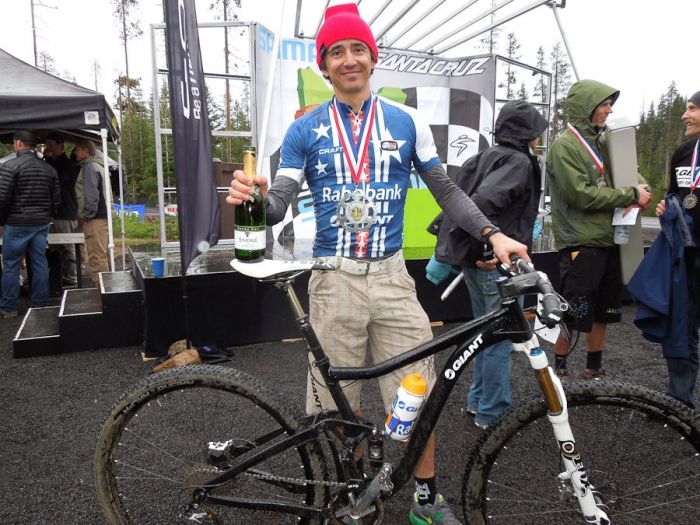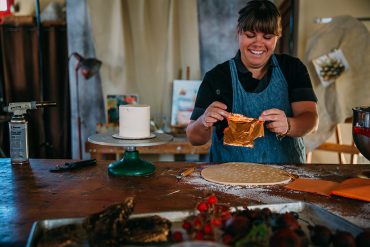When Jenny and Dave Sheldon left Jackson, Wyoming to move to Bend in 1975, they brought with them the idea of a new type of outdoor sports competition involving alpine and Nordic skiing, paddling and cycling, an event similar to what had been run successfully in Jackson that spring.
Settled in Bend and with a season of skiing at Mt. Bachelor under their belts, the Sheldons decided a multisport event would go over well with Bend’s growing outdoor sports community.
In May of 1976, they staged Bend’s first Pole Pedal Paddle. “It was a drought year,” recalls Bend native and former alpine ski coach Terry Foley, “and there wasn’t enough snow to have the alpine leg of the race.”
From that year on, the format for the Pole Pedal Paddle (dubbed the PPP) was set. It begins with a short mass-start uphill run to alpine skis and the top of the downhill ski leg of the race. Downhill skiers then switch skis and boots to begin the 5-mile cross-country ski on a course that ends in a grueling quarter-mile climb to the bike transition. The 25-mile cycling leg from Mount Bachelor to Bend is predominantly downhill, with one tough hill climb within the first few miles. The transition from the bike to the 5-mile run is often cited as being the toughest. Today’s running course follows Century Drive back up the mountain, with a little elevation gain and back to the Old Mill District along the Deschutes River. From there, runners take to kayak, canoe, or anything that floats on the Deschutes River for a mile and a half paddle. Finally, a scramble ashore and a short sprint to the finish line in the Old Mill District.
From its inception, the race was divided into two distinct participation categories: individuals and teams. Within the team competition there are many sub-categories from mixed teams to same-sex teams, to pairs in different combinations and all in various age brackets. Today, there are a total of forty-five team classes in the event.
In the PPP’s early years, individual male and female winners were experienced alpine skiers. That quickly changed as Bend became known as a premier North American destination for Nordic ski racers in training. From the late ,70s on, the race’s individual competition has been dominated by cross-country skiers.
Justin Wadsworth, a former Olympian (Lillehammer, Nagano, Salt Lake City) holds the record for the most individual wins by a male with eight. Second to Wadsworth with six wins is Ben Husaby, another former Olympian (Albertville and Lillehammer).
Husaby’s wife, Julie Verke, won the women’s title five times, a record she shares with Suzanne King, two-time Olympian (Lillehammer and Nagano).
On the surface, it would appear that Nordic skiing Olympians would always have the edge. It wasn’t always so as three-time Olympian (Lake Placid, Sarajevo and Calgary)Dan Simoneau found out. “In the 1985 PPP,” Simoneau recalled, “I figured, as an Olympian, I could do anything. I opted to paddle a very fast but unstable kayak, thinking I could muscle through the paddle leg.”
Simoneau was well ahead in the individual competition when it came to the paddle, the last long leg. On the water, things started to unravel. “I dumped the boat three times and had to swim to shore to empty it and get going again,” he says. “Soon people were passing me. Two more bailouts and swims, and I went from first to a very wet fifth. I became famous that day for my swimming.”
The following year, Simoneau listened to the advice of experienced paddlers and opted for a sluggish yet stable kayak and won the individual title handily. A year after that, with months of paddling training, he went back to the fast, narrow and unstable kayak. By then, he had learned to balance the reed-like boat to win his final PPP.
During Simoneau’s agony of defeat and winning years, the PPP came of age. The number of participants soared and it gained recognition as one of the Pacific Northwest’s top sporting events. The PPP’s individual winners also started to earn a modicum of fame.
“I remember walking into a meeting at the Inn of the Seventh Mountain just after the PPP in 1987,” Simoneau laughs. “The resort’s sales manager looked at me and said, ‘I know who you are. You’re the PPP winner.’”
Though the PPP is a track for elite racers, it quickly became the playground for the masses. The event started attracting top athletes from all over the West as well as hundreds of weekend warriors battling for age and team division titles.
Costumes now range from silly to outrageous and have become part of many teams’ raison d’être. From the looks of it today, more teams spend as much time crafting their team name and costumes as they do on training for the event. Take last year’s duo, Bangers and Mash Reunited, and men’s teams like the Kilt Lifters, Into Thin Hair and Tour de Pends. Among the women’s teams were The Hot Flashes, We Bust Ours 2 Kick Urs and Mentalpausal.
A few teams take the event seriously, but, surprisingly, the fastest team time ever set for the PPP (one hour and thirty-one minutes) was set in 2001 by a team of Bend locals who decided to race just hours before the event.
“Two days before the race, Mike Dudley, who’d just gotten back from a running camp at the U.S. Olympic Training Center in Colorado Springs, said he wanted to put together a PPP team,” says Mike McMackin of Hutch’s Bicycles in Bend. McMackin quickly called eight-time winner Wadsworth to see if there were any hot Nordic skiers around who might like to join a team. “Wadsworth said he wasn’t doing anything and would gladly join in.”
Within minutes of the drop-dead deadline for entries, McMackin entered a team composed of himself skiing the alpine leg, Wadsworth doing the cross-country leg, cyclists Jim Lewis and Mark Katter doing the bike leg on a tandem bike, Mike Dudley doing the run and longtime local kayak instructor Greg Terhaar paddling.
In search of fast times, fun, and camaraderie, the PPP’s entries have gone from eighty in the event’s first year to a record high of 2,932 competitors in 2009, with 257 racing as individuals.
“The PPP is so much fun because there are so few events that allow you do all the sports you like in one day,” notes Portlander Mary Ross, 52, who competes on a team with her husband, Mike Resnik. “Then there’s the weather, which is always interesting. You never know if it’ll be winter or summer come race time.”
As much as May seems the perfect month to hold the race in Central Oregon the weather has not always totally been compliant. “Several years at the PPP, I’ve started the bike leg in freezing temperatures and six inches of snow and then arrived in town to 75 degree temperatures,” laughs Foley, the former alpine ski coach.
How a little technique can make you faster
Four-time PPP winner (’06-’09) and XC Oregon elite cross-country ski racer Marshall Greene, 28, cites pacing as the most important overall aspect of competing in the individual PPP. “Especially in the initial run up to the alpine skis, don’t sprint,” he says. “Relax and don’t go anaerobic in the first thirty seconds of the event and then never recover.”
Like most great individual PPP competitors, Greene wears his cross-country ski boots inside his oversize alpine boots for the mass start and then jumps out of his alpine boots into his Nordic skis for a fast transition.
“For the cross-country leg, I never lace my boots but simply zip up their boot covers and tighten the buckles over the ankles. That makes it easy to get the boots off to get into my cycling shoes.”
On the bike, Greene uses the first few miles to consume energy food and drink. “It’s the only chance you’ll have to replenish—so get it done.”
Pacing is also the key to the run leg along with training that consists of bike rides followed by a run. “A lot of people cramp in the race when they jump off the bike and start running.”
Finally to the paddle, where he hugs the right side of the Deschutes River going upstream to make better headway. And though the river is still cold in May, Greene implores competitors to practice paddling before race day.
The Right
Stuff for the PPP
If you want to compete in style,
here are some ideas on the right gear to use.
Alpine ski leg
Good: Recreational alpine (slalom) skis
Better: GS or Super G skis
Best: Downhill racing skis
Cross-country ski leg
Good: Stable waxless skis
Better: High performance skate skis
Best: Racing skate skis waxed to perform
Cycling leg
Good: A stock road bike
Better: A road racing bike with low gearing
Best: A time-trial bike with aero bars and rear disk wheel and aero helmet
Running leg
Good/Better/Best: Shoes that are easy to put on and are relatively lightweight
Paddling leg
Good: A stable touring kayak or recreational canoe
Better: A sea kayak with a rudder
Best: Either a downriver racing kayak or surfski
Cost
Good Gear: Stuff you or your teammates already own
Better Gear: Time to stress the credit card a bit
Best Gear: Contact a lending institution pronto
Early registration deadline is April 20 ($67).
Regular registration deadline is May 10 ($77).









